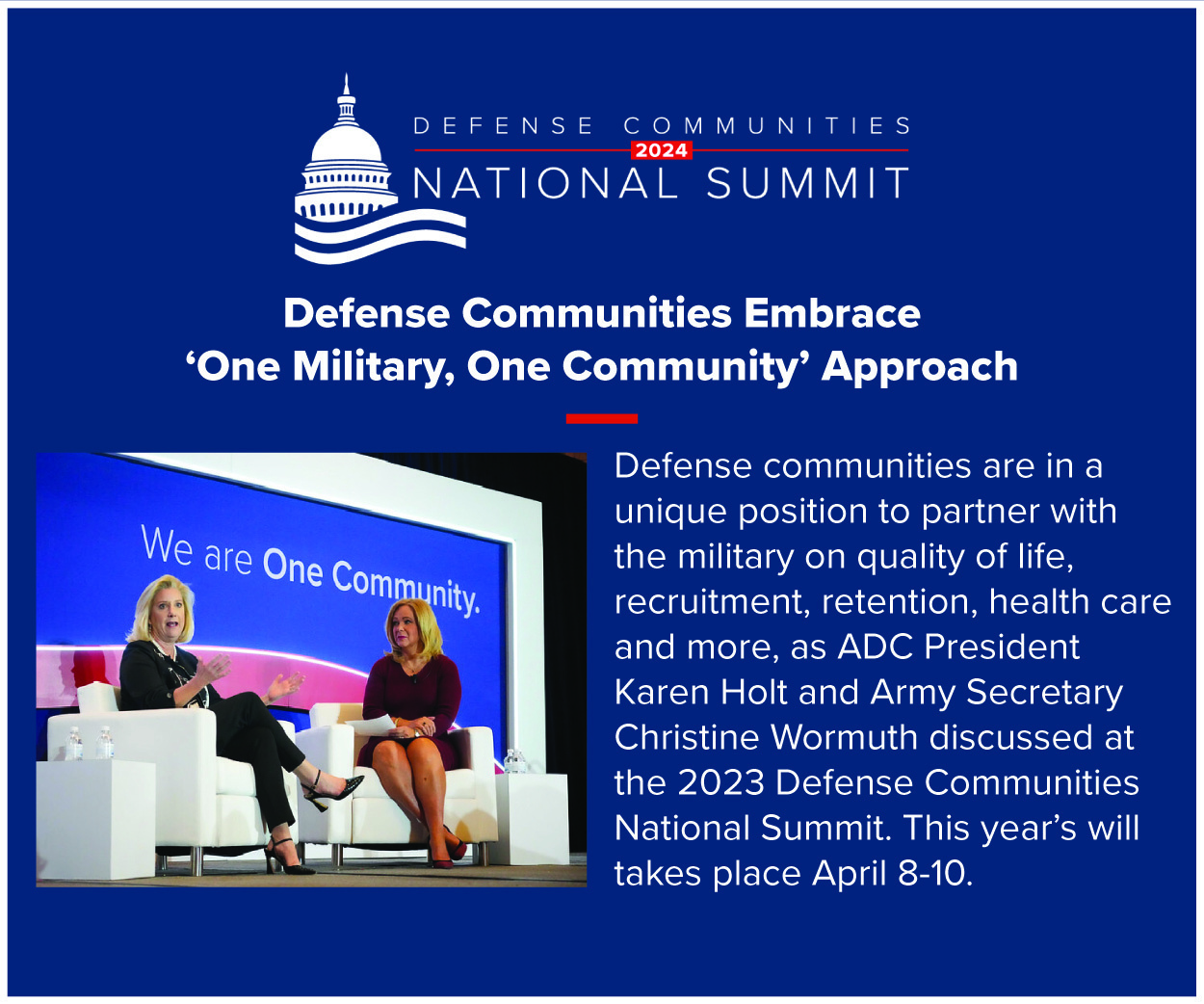Sponsored Content
Defense Communities Embrace ‘One Military, One Community’ Approach
By: Randy Ford, On Base Editor, Association of Defense Communities
Defense communities from across the country, members of Congress, Department of Defense leaders and industry partners will convene in the D.C. area in April to discuss military quality of life, what it means for states to be “military-friendly,” the power of military spouses and more. When it comes to a “One Military, One Community” approach, the conversations at events like the Defense Communities National Summit are vital to the future of defense policy, active-duty service members and their families.
When a service member or military family moves to a new base, they’re also moving to a new community. As they get to learn their new installation, they’re also learning about the community around them – schools, job opportunities, places to worship, where to buy groceries.
Their quality of life is dependent on conditions at the installation, including their commanders, their peers, and DOD programs and infrastructure. But it is also dependent on a resilient, thriving community on the other side of the fence line.
Fortunately, America’s defense communities are proud to host military missions and the service members and families who keep the country safe. They welcome them and actively look for ways to partner with DOD, the services, installations and individual service members.
That’s the basis of the “One Military, One Community” concept championed by the Association of Defense Communities (ADC). With more than 300 members, ADC represents the cities, states and regions that the military calls home and their partner organizations. ADC will celebrate its 50th anniversary in 2026.
“It is a partnership that’s necessary, because when you look at the fact that 70% of the people who work on military installations live in the community, it’s not just about hardening inside the fence line,” Brendan Owens, assistant secretary of defense for energy, installations, and environment, told America’s Defense Communities magazine last year. “With that as kind of the backdrop, there are strategies that will make communities more resilient, and some of those are DOD-funded.”
The Defense Community Infrastructure Program, for example, helps communities build more resilient infrastructure. The Defense Manufacturing Community Support Program makes long-term community investments to expand the capabilities of the defense manufacturing industrial ecosystem. Congress also continues to fund the Office of Local Defense Community Cooperation, a strong ally that supports innovative partnerships between communities and installations.
More than a decade ago, Congress formalized the process of enacting intergovernmental service agreements (IGSA) that allow installation-community partnerships. Those often include municipal services such as water and electricity, but across the country, leaders on both sides of the fence are starting to innovate further, exploring partnerships with colleges and universities to improve workforce development and provide new opportunities for military spouses and separating service members.
“[W]e have strong and long-established partnerships with other government agencies, state and local governments, academic institutions, and civil society organizations in the communities in which we operate,” DOD leaders wrote in the “Strategy for Resilient and Healthy Defense Communities,” released in February. “We will continue to explore ways of collaborating with these stakeholders to deliver high-quality infrastructure in cost effective ways, including maximizing the use of… IGSA… with state and local governments to provide, receive or share installation support services.”
Service members and defense community civilians directly interact on a day-to-day basis. Other localities with fewer military-connected families can learn from the successes defense communities have made in bridging the military-civilian divide.
“Community-led programs like the Career and Technical Education, or CTE, program in Tullahoma, Tennessee, and the cybersecurity and coding program in Little Rock, Arkansas, introduce military life to students in our communities,” ADC President Karen Holt wrote last year for Military Times. “They are impactful and should be supported and embraced. An investment in expanding these programs to other communities, along with DOD’s youth engagement initiatives, such as the Starbase outreach program, could pay dividends now and into the future.”
As the U.S. military innovates and prepares for the challenges ahead, defense communities are ready to continue their partnerships to making our military missions, service members and military families the best they can be.
Join ADC at the Defense Communities National Summit April 8-10 as defense community leaders continue the conversation of how they can support mission readiness and military families.

